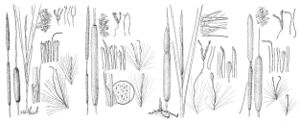Difference between revisions of "Typha latifolia"
Sp. Pl. 2: 971. 1753.
FNA>Volume Importer |
FNA>Volume Importer |
(No difference)
| |
Revision as of 19:02, 24 September 2019
Erect shoots 150–300 cm; flowering shoots 1–2 cm thick in middle, stems 3–7 mm thick near inflorescence. Leaves: usually glaucous when fresh; sheath sides papery or membranous, margins narrowly clear, summit tapered into blade to distinctly shouldered, or rarely with firm, papery auricles; mucilage glands at sheath-blade transition usually colorless, obscure, absent from sheath center and blade; widest blades on shoot 10–23(–29) mm wide when fresh, 5–20 mm when dry, distal blades about equaling inflorescence. Inflorescences: staminate spikes contiguous with pistillate or in some clones separated by to 4(–8) cm of naked axis, about as long as pistillate, ca. 1–2 cm thick at anthesis; staminate scales colorless to straw-colored, filiform, simple, ca. 4 × 0.05 mm; pistillate spikes in flower pale green drying brownish, later blackish brown or reddish brown, in fruit often mottled with whitish patches of pistil-hair tips, 5–25 cm × 5–8 mm in flower, 24–36 mm thick in fruit; compound pedicels in fruit bristle-like, variable in same spike, 1.5–3.5 mm; pistillate bracteoles absent. Staminate flowers 5–12 mm; anthers 1–3 mm, thecae yellow, apex dark brown; pollen in tetrads. Pistillate flowers 2–3 mm in flower, 10–15 mm in fruit; pistil-hair tips colorless, whitish in mass, not enlarged; stigmas persistent, forming solid layer on spike surface, pale green in flower, drying brownish, then reddish brown or usually distally blackish, spatulate, ovate to ovate-lanceolate, 0.6–1 × 0.2–0.25 mm; carpodia exceeded by and hidden among pistil hairs, straw-colored, apex rounded. Seeds numerous. 2n = 30.
Phenology: Flowering late spring–summer in north, spring–early summer in south.
Habitat: Fresh to slightly brackish water or wet soil
Elevation: 0–2300 m
Distribution

Alta., B.C., Man., N.B., Nfld. and Labr. (Nfld.), N.W.T., N.S., Ont., P.E.I., Que., Sask., Yukon, Ala., Alaska, Ariz., Ark., Calif., Colo., Conn., Del., Fla., Ga., Idaho. Ill., Ind., Iowa., Kans., Ky., La., Maine, Md., Mass., Mich., Minn., Miss., Mo., Mont., Nebr., Nev., N.H., N.J., N.Mex., N.Y., N.C., N.Dak., Ohio, Okla., Oreg., Pa., R.I., S.C., S.Dak., Tenn., Tex., Utah, Vt., Va., Wash., W.Va., Wis., Wyo., Mexico, Central America, South America, Eurasia, Africa, Australia (Tasmania (introduced)).
Discussion
The erect shoots of Typha latifolia are more fanlike when young than in other North American species because the proximal leaves (dying by mid season) spread more widely. Undoubtedly native throughout its North American range, where it is often a codominant or minor component of marshes, wet meadows, fens, and other communities. In many places it is apparently being replaced by T. angustifolia and T. angustifolia × T. latifolia (T. ×glauca) at least partly due to human disturbance of habitats. There is a specimen of T. xglauca from Anticosti Island, Quebec. Locally in California and perhaps elsewhere where hybrids are common, the pollen grains of some T. latifolia plants separate slightly and may be shed partly as mixtures of triads, dyads, and monads, perhaps due to introgression ([S. G. Smith, unpublisheddeletion.). Ph.D. thesis]. See also hybrids in key and genus.
